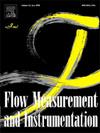Near-field flow features of underexpanded microjets emerging from a rectangular convergent nozzle with a high-aspect-ratio
IF 2.7
3区 工程技术
Q2 ENGINEERING, MECHANICAL
引用次数: 0
Abstract
Underexpanded microjets emerging from a rectangular convergent nozzle with an aspect ratio of 10 at the exit face are quantitatively visualized via Mach–Zehnder tomography (MZT) with the finite-fringe setting. Multiview interferograms around the central axis of the microjet are taken at a nozzle pressure ratio (NPR) of 4.0. The Reynolds number based upon the height in the minor-axis plane and flow properties at the nozzle exit is 1.74 × 104. Fourier fringe analysis is utilized to extract the phase shifts between the background fringe and deformed fringe patterns. The density fields of the microjets are subsequently reconstructed via the convolution back-projection (CBP) method. Near-field flow features of the microjets are demonstrated with the isopycnic surface as well as the density contour plots in the minor-axis and major-axis planes. In addition, microjets issuing from the nozzle with the same geometry as in the experiment are solved via the Reynolds-averaged Navier–Stokes (RANS) equations with Menter’s shear stress transport (SST) turbulence model for mutual comparison with the experimental results. The streamwise density profiles along the jet centerline as well as the liplines in the minor-axis and major-axis planes are quantitatively compared between the experimental and simulation results. Shock structures and topology showing the streamwise evolution of a shock system in a high-aspect-ratio rectangular microjet are experimentally clarified for the first time with a high spatial resolution of approximately .
高展弦比矩形会聚喷管欠膨胀微射流近场流场特征
在有限条纹设置下,通过马赫-曾德断层扫描(MZT),定量地观察了从长宽比为10的矩形会聚喷嘴在出口面上出现的未膨胀微射流。在喷嘴压力比(NPR)为4.0的情况下,拍摄了微射流中轴线周围的多视点干涉图。基于小轴平面高度和喷管出口流动特性的雷诺数为1.74 × 104。利用傅里叶条纹分析提取背景条纹和变形条纹之间的相移。随后通过卷积反投影(CBP)方法重建了微射流的密度场。利用等流面以及小轴面和长轴面的密度等高线图展示了微射流的近场流场特征。此外,采用Menter剪切应力输运(SST) k−ω湍流模型,利用reynolds -average Navier-Stokes (RANS)方程求解了与实验相同几何形状的喷嘴发出的微射流,并与实验结果进行了比较。对实验结果和模拟结果进行了定量比较,得到了沿射流中心线以及小轴和长轴平面的密度分布。本文首次在实验上以约5.0μm的高空间分辨率阐明了高展弦比矩形微射流中激波系统的激波结构和拓扑结构。
本文章由计算机程序翻译,如有差异,请以英文原文为准。
求助全文
约1分钟内获得全文
求助全文
来源期刊

Flow Measurement and Instrumentation
工程技术-工程:机械
CiteScore
4.30
自引率
13.60%
发文量
123
审稿时长
6 months
期刊介绍:
Flow Measurement and Instrumentation is dedicated to disseminating the latest research results on all aspects of flow measurement, in both closed conduits and open channels. The design of flow measurement systems involves a wide variety of multidisciplinary activities including modelling the flow sensor, the fluid flow and the sensor/fluid interactions through the use of computation techniques; the development of advanced transducer systems and their associated signal processing and the laboratory and field assessment of the overall system under ideal and disturbed conditions.
FMI is the essential forum for critical information exchange, and contributions are particularly encouraged in the following areas of interest:
Modelling: the application of mathematical and computational modelling to the interaction of fluid dynamics with flowmeters, including flowmeter behaviour, improved flowmeter design and installation problems. Application of CAD/CAE techniques to flowmeter modelling are eligible.
Design and development: the detailed design of the flowmeter head and/or signal processing aspects of novel flowmeters. Emphasis is given to papers identifying new sensor configurations, multisensor flow measurement systems, non-intrusive flow metering techniques and the application of microelectronic techniques in smart or intelligent systems.
Calibration techniques: including descriptions of new or existing calibration facilities and techniques, calibration data from different flowmeter types, and calibration intercomparison data from different laboratories.
Installation effect data: dealing with the effects of non-ideal flow conditions on flowmeters. Papers combining a theoretical understanding of flowmeter behaviour with experimental work are particularly welcome.
 求助内容:
求助内容: 应助结果提醒方式:
应助结果提醒方式:


